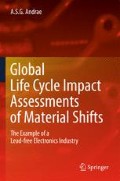Abstract
This chapter describes in detail how LCIA calculations can be performed in practice to compare interconnection materials. Several software programs are discussed with special emphasis on the Excel-based software EMLCA. One possible methodology for performing an LCIA of interconnection materials is presented. Concerning consequential LCA, a procedure for identifying marginal consumers is proposed. This text makes a summary of the important issues regarding the remaining needs for carrying out a successful consequential LCA in practice. The effect on the markets of Pb, Ag, Sn, and Bi as a result of the Pb-free shift is explored.
Access this chapter
Tax calculation will be finalised at checkout
Purchases are for personal use only
Preview
Unable to display preview. Download preview PDF.
References
Haapala KR, Rivera JL, Sutherland JW (2008) Application of life cycle assessment tools to sustainable product design and manufacturing. Int J Innov Comput, Inform Control 4:575–589
Ciroth A (2007) ICT for environment in life cycle applications openLCA – a new open source software for life cycle assessment. Int J LCA 12:209–210
Andrae ASG (2005) Environmental life-cycle assessment in microelectronics packaging. PhD thesis, Chalmers University, Gothenburg, Sweden
Lu W (2006) Study on the advanced technique of environmental assessment based on life cycle assessment using matrix method. PhD thesis, The University of Tokyo, Tokyo, Japan
Sullivan CR (1994) Energy use: the most important impact of electronic equipment? Proc. IEEE Int Symp Electron Environ, 2–4 May, San Fransisco, CA, 261–266
Frischknecht R, Rebitzer G (2005) The ecoinvent database system: a comprehensive webbased LCA database. J Clean Prod 13:1337–1343
Wolf MA (2008) Supporting life cycle based policies and applications in industry with recommended LCI practice and the ELCD-consistent LCI data network. Pres at SETAC Europe Annual Meet, May 25–29, Warzaw, Poland
Huisman J, Stevels ALN, Stobbe I (2004) Eco-efficiency considerations on the end-of-life of consumer electronic products. IEEE Trans Electron Packag Manuf 27:9–25
Ekvall T, Andrae ASG (2006) Attributional and consequential environmental assessment of the shift to lead-free solders. Int J LCA 11:344–353
Lesage P, Deschenes L, Samson, R (2007) Evaluating holistic environmental consequences of brownfield management options using consequential life cycle assessment for different perspectives. Environmental Management 40:323–337
Sandén, BA, Karlstrom M (2007) Positive and negative feedback in consequential life-cycle assessment. J Clean Prod 15 :1469–1481
Eriksson O, Finnveden G, Ekvall T et al (2007) Life cycle assessment of fuels for district heating: A comparison of waste incineration, biomass- and natural gas combustion. Energy Policy 35:1346–1362
Thomassen MA, Dalgaard R, Heijungs R et al (2008) Attributional and consequential LCA of milk production. Int J LCA 13:339–349
Newcomer A, Blumsack SA, Apt J et al (2008) Short run effects of a price on carbon dioxide emissions from US electric generators. Environ Sci Technol 42:3139–3144
Hübler O, Frohn J (2007) Modern econometric analysis. Springer, Berlin, Heidelberg
Weidema BP, Frees N, Nielsen AM (1999) Marginal production technologies for life cycle inventories. Int J LCA 4:48–56
Ekvall T, Weidema BP (2004) System boundaries and input data in consequential life cycle inventory analysis. Int J LCA 9:161–171
Lanzano T, Bertram M, De Palo M et al (2006) The contemporary European silver cycle. Resour Conserv Recycl 46:27–43
Naumov A (2007) World market of bismuth: a review. Russ J Non-Ferr Met 48:10–16
Hendrickson CT, Lave LB, Matthews HS (2006) Environmental life cycle assessment of goods and services: an input–output approach. Resources for the Future Press
Park PJ, Tahara K (2008) Quantifying producer and consumer-based eco-efficiencies for the identification of key ecodesign issues. J Clean Prod 16:95–104
Heijungs R, Suh S (2002) The computational structure of life cycle assessment, Kluwer, Dordrecht
Rights and permissions
Copyright information
© 2010 Springer-Verlag London Limited
About this chapter
Cite this chapter
(2010). Methodology. In: Global Life Cycle Impact Assessments of Material Shifts. Springer, London. https://doi.org/10.1007/978-1-84882-661-8_4
Download citation
DOI: https://doi.org/10.1007/978-1-84882-661-8_4
Publisher Name: Springer, London
Print ISBN: 978-1-84882-660-1
Online ISBN: 978-1-84882-661-8
eBook Packages: EngineeringEngineering (R0)

